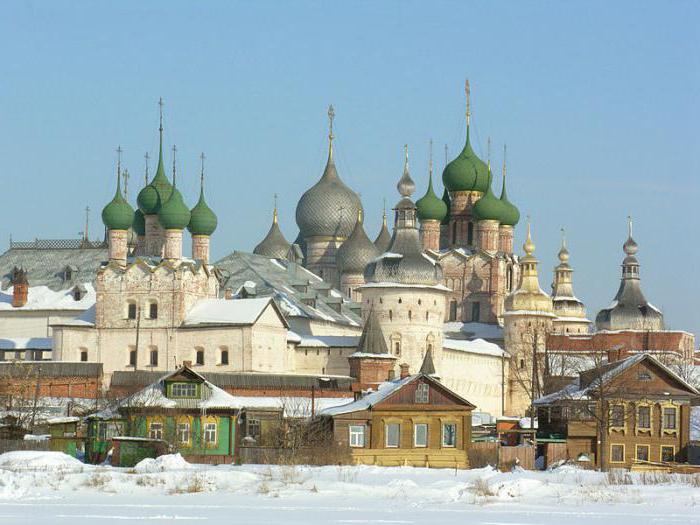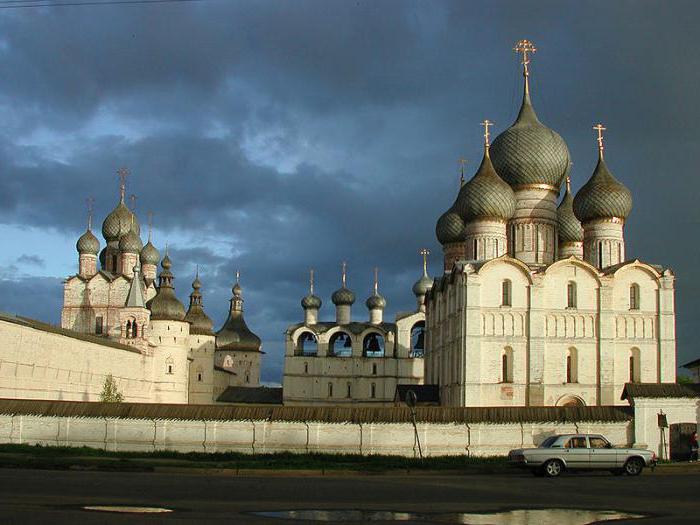The program of many excursions along the Golden Ring of Russia includes the city of Rostov the Great. The Kremlin strikes his imagination with an abundance of gilded domes. Is it a defensive structure or one walled monastery? You will learn from this article. We will also tell you what you should see in the Kremlin of Rostov the Great. After all, the complex is very extensive. It consists of the Assumption Cathedral, five churches and a number of residential and farm buildings. There is also a garden. Before we begin our virtual tour of the Kremlin, it should be said that it was seen by many people who did not even come to Rostov the Great. After all, this ancient residence became natural scenery in the filming of the cult Soviet film comedy "Ivan Vasilyevich Changes the Profession."
How to get there and other useful information
The address of this attraction is simple: Russian Federation, Yaroslavl region, Rostov Veliky, Rostov Kremlin. Getting to her is also easy. By your own vehicles, you must go to the highway leading from Moscow to Kholmogory. Direct electric trains and trains to Rostov Veliky run from the capital Yaroslavl Station. From the metro station "Schelkovskoe" to this city buses and minibuses depart. So it’s quite possible to arrange a short one-day excursion to this ancient Kremlin. In the city, finding it is not difficult. Golden domes of churches are visible from almost anywhere in old Rostov. The Kremlin works like a museum. It is open from ten to seventeen hours. The museum operates on a single day off - January 1. But here the frescoes of ancient temples and powerful fortification walls are open for viewing by tourists only in the warm season - from May 1 to October 1. A ticket for an adult costs three hundred rubles, and for a child or a pensioner it costs one hundred and eighty.

What is the Kremlin?
We are in no hurry to enter the wide entrance gate. First we will admire the whole complex from a distance, from the shore of Lake Nero. And while we will take beautiful photos, we will listen to a short Kremlin building course. In the Middle Ages in Russia, it was customary to enclose important settlements with fortification walls. The name “Kremlin” is etymologically derived from the Old Russian word “to protect”, “to separate”. In the Ukrainian language, as more authentic, there is the verb "vidokremlyuvati." Thus, the so-called territory separated from unprotected land. These neighborhoods were called “Posad”. In the event of the arrival of the enemy, the population was hiding behind the walls of the Kremlin. Only this citadel could resist siege and assault. But can the Kremlin of the Great Rostov be called that? It turns out, no. From a distance, he looks menacing and stately. But let’s come closer and we will understand what’s the matter.
Kremlin (Rostov the Great): history
Beyond the walls of the fortress was supposed to be the prince with his armed squad. All the Kremlin in Russia bear the imprint of fortification construction. They are equipped with massive walls with loopholes. Turrets were located above the entrance gates so that the defenders could repel the attack of the besiegers. The Kremlin was often further fortified by a moat filled with water. There was a bridge over it, which, in case of danger, was lifted by a special mechanism. All this is not in the Rostov Kremlin. Because it was built according to a different plan. And not in those days. The author of the creation is the Metropolitan of the Rostov Diocese of Ion Sysoevich. In 1670, he planned to build his residence on the model of the “city of God protected from the world”. Monasticism was considered an “angelic rank,” and therefore the Metropolitan wanted to dwell “almost” in the Garden of Eden. It was supposed to create a single ensemble, designed in a single style. It should have organically combined churches, gardens, ponds. Approaching the main gate, we see that the residence of the Metropolitan is a pseudo-Kremlin. If the enemy approached with artillery, he would be completely defenseless.

Kremlin construction
Metropolitan Jonah Sysoevich did not live to see the end of work and could not admire his brainchild. His work was continued by the successor in the department - Joasaph. The Kremlin of Veliky Rostov was fully completed only by the year 1700. That is, it was built for about thirty years. But here the story has made its own adjustments. Yaroslavl has become a livelier and larger city than Rostov the Great. And the department of metropolitans was moved there. It happened in 1787. The Rostov Kremlin gradually deteriorated. There were no divine services in churches, and the metropolitan chambers and other buildings were rented out for warehouses. In the mid-nineteenth century, local bishops generally decided to give the Kremlin to demolition. The attraction of Rostov the Great was saved by the local merchants. In the 1860s and again in the 1880s, charity donations for the restoration of the complex were collected. Already in 1883, the first museum was opened to the public - church utensils.

Turning into a nature reserve
Things have gone quite well for the restoration of the ancient monument since 1886. Then the successor to the throne, Nicholas II, took the Kremlin of Great Rostov under his personal patronage. Since then, all the high nobility of the Russian Empire considered it a duty to donate a certain amount (and considerable) to the restoration of the ancient residence of the metropolitans. And in 1910, the Duma, by its decree, assigned the status of the All-Russian Museum to the Rostov Kremlin. From now on, the cargo for the maintenance of the monument was removed from the shoulders of the public. Funds were released from the state treasury. The Soviet government did not begin to change anything. Only in 2010 did the Orthodox Church of the Moscow Patriarchate encroach on the monument. It was supposed to evict museum exhibits into a new building, and the chambers and churches should be given over to the bishop's residence. Only under public pressure was this project curtailed.
Rostov the Great, Kremlin: excursions
If you set out to thoroughly examine all the buildings of the Metropolitan’s residence, you will have to spend at least several days in the city. Eleven towers, walls, temples and belfries, an economic courtyard. And why are only the chambers of the "humble" servant of God Jonah Sysoevich! You can see the main attractions of the Rostov Kremlin yourself. But it will be much more interesting to listen to an interesting guide story. At the box office you can buy several types of tickets. Indeed, within the walls of the residence there are several museums: local history, cannons, enamels, bells and bells, etc. But if you want to climb the fortifications and see the preserved frescoes of the temples, you need to buy a ticket for the excursion “Transitions along the walls of the Kremlin”.
Assumption Cathedral and belfry
Focus on the main buildings of the residence. The Assumption Cathedral in the form in which we see it is already the fifth in a row. It is known that in the tenth century there was a city church. The temple was rebuilt and expanded several times. This cathedral was built in the seventeenth century. Its architecture is influenced by the Moscow style. Probably, the metropolitan ordered the architects to make a copy of the Assumption Cathedral of the metropolitan Kremlin. The bulbous heads of the temple were built a century later (they were preceded by helmet-shaped, covered with a ploughshare). It is worth going inside to admire the iconostasis and see the necropolis of the metropolitans. There is also the grave of Jonah Sysoevich. The bell tower was erected at the end of the seventeenth century. It is worth listening to the melodic chime - it is the Kremlin in Rostov the Great that is famous for it.
Bishop's yard
We move from the northern part of the complex to the central one. This, in fact, is the Kremlin of Great Rostov. The chambers of the metropolitan are fenced with walls. Above the entrance, two gate churches rise - the Resurrection and John the Theologian. The chambers themselves house museum exhibits.